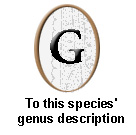

|
|
Description: (from Hunt, 1993; modified from Siddiqui,
1976)
Female: Body small, slightly attenuated anteriorly, narrowing posterior
to anus, lying straight with a slight curvature of the tail region when
heat relaxed. Cuticle finely annulated, annules 0.8um wide. Lateral
fields occupy 16-18% of body diameter at the mid-body region; there
are two distinct longitudinal lines between which lies a narrow refractive
band. The two longitudinal lines merge into a single line about one
body diamenter anterior to the median bulb, the line gradually disappearing
approximately one-half body diameter anterior to the merging point; posteriorly
the two lines disappear about three body diameters behind the anus. Cephalic
region distinctly set off from body, appearing smooth and with six equal
lips. Refracrtive cheilorhabdions seen near the oral aperture slightly
anterior to the stylet tip. Stylet 10-12um long with distinct basal knobs.
Cylindrical portion of the stylet slightly longer than the anterior conical
section. Procorpus wider anteriorly, gradually narrowing posteriorly, and
then widening at the median bulb. Median bulb pyriform to spherical in
shape and occupying four-fifths of the body width. Oesphageal glands form
a lobe overlapping the intestine dorsally, 50-75um in length. Nerve ring
about one-half body width behind median bulb, encircling anterior end of
the oesophageal glands and intestine. Excretory pore usually opposite
anterior margin of nerve ring, but sometimes as far anterior as the basal
portion of the median bulb.Hemizonid four annules wide, located 16-18um
posterior to excretory pore. Deirids and phasmids not seen. Vulva a transverse
slit, two-fifths body width long and located approximately two-thirds body
length from anterior end. Genital tract monoprodelphic, outstretched
but reflexed at the apex in well fed specimens. It usually extends to
the oesophageal gland lobe but occasionally even beyond the median
bulb. Oocytes arranged in a single row. Post-uterine sac 2.5-3 anal
body widths long, with its terminus directed ventrally. Tail
4.5-5 anal body widths long, tapering gradually beyond anus, and terminating
in a bifurcate tip of which the ventral prong is acute and always longer
than the dorsal prong.
Male: Extremely rare, slightly smaller than female. Stylet 10.5um long. Anterior portion of the body similar to the female. Single testis extending anteriorly to about three body widths behind the posterior margin of the oesophageal gland lobe. Spicules equal in size and typically aphelenchoid in shape. Tail without bifurcation, measuring 2.5 body widths long. In the two specimens observed, it narrows gradually and then abruptly to form a centrally located mucro approximately 3.5um long. Two pairs of ventrosublateral caudal papillae observed, one pair adanal and the other pair midway along the tail.
Bionomics: Aphelenchoides bicaudatus is mycetophagous and is commonly found in the rhizosphere of many crops and other plants in the warmer regions of the world. It is known to feed on mushroom mycelium, but does not appear to be a serious pest. Reproduction is parthenogenetic and the life cycle lasts 5-6 days at 28C (Siddiqui, 1976).
Distribution: Recorded from most of the tropical and subtropical regions of the world and also from some of the warmer temperate areas.
 |
 |